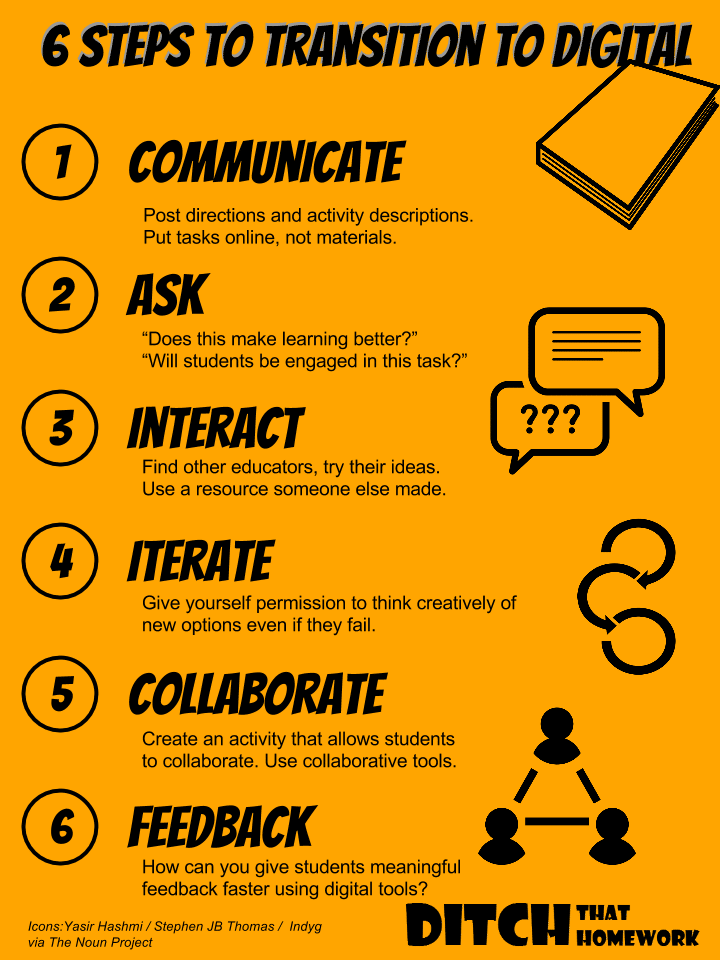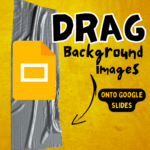
Transitioning to Digital
When you’re moving to digital platforms and students having devices, what do you do first?
Not Materials Online
Your first move is NOT to just post all your documents online. Nor is it to make a bunch of videos of you teaching.
Paradigm Shift
Using digital materials should be more than going paperless. It is a mind shift of attitude and approach. “What does this allow me to do that I could not do before?” “Why is this BETTER?” Just because something is digital, does not make it better. The same task will yield the same results. Asking students to read a book on a tablet does not improve the learning.
So, do NOT just try to digitize everything you have.
Moving to digital is a great excuse to rethink how we approach teaching and learning in a modern context. We teach the future, we want to be forward thinking.
Substitution
The SAMR model helps us to look at how we are using our materials. SAMR is NOT a ladder, you do not start with substitution and move your way up to redefining the task. SAMR is also NOT a measure of difficulty. Some substitution level tasks are harder than a modification or redefinition task.
If you are “getting there” or “easing into” transitioning to digital, don’t give up what you’re already doing. Keep your textbook and paper. Learn something new that makes learning better, that is better for kids in conjunction with what you’re already doing. Don’t waste your new learning on learning how to do old things in a new way. Learn something new. Every day we ask kids to learn something new, it is energizing to learn something new alongside them.
6 Steps to Transition to Digital
1. Communicate
How can we use digital tools to better communicate what we are doing? Get in the habit of posting the tasks students will be doing during the day. This opens up transparency with parents and students. Parents can have specific things to refer to when talking to their child after school. “Tell me about the book you read in class today” as opposed to “What did you do today?” Students who are absent can more easily get caught up, or even to not miss a beat before coming back to class.
A website, Google Classroom, a digital newsletter, a digital Padlet board, a class Twitter account, class Facebook page, directions on a Google Doc or Google Slides, text messages using Remind are some suggestions for communicating digitally, directions on a Google Doc or Google Slides.
Not repeating myself makes me less grumpy. If tasks along with directions are posted digitally, students can access directions and get to work without waiting. Directions can be referenced multiple times to ensure they are being followed.
2. Ask
Before you jump into teaching with digital materials, ask some questions.
“Does this make learning better?” If not, why are we trying to do it digitally? Perhaps the old fashioned way of doing it is better for teacher and student.
“Will students be engaged in the task?” No matter the medium, we must design for student engagement. Digital tools do not create engagement, we can not rely on the glow of a computer screen to excite kids. Completing worksheets online is not engaging. How does the technology change the assignment to better engage students in their learning?
3. Interact
Teaching is too hard to do in isolation. Especially as we transition to digital tools, you can not know how to use all of the possible technology options. Before trying to come up with your own ideas, look for what others are doing. “Steal” someone else’s activity. I highly recommend you create a PLN of teachers you regularly interact with who will share their lesson activities. Try one of them. As you are transitioning to digital materials, do not feel the pressure to jump in the deep end. Try one new activity, see how it goes. Make some adjustments, try the activity again. Talk to other educators on how it went, get feedback.
4. Iterate
Give yourself permission to try something new and realize it possibly will not come out like you expected. Creativity is something you practice not something you’re born with. Try coming up with one idea for a digital activity or resource you can try that you haven’t done before.
5. Collaborate
When designing digital activities consider “how will my students collaborate?” Before you make all of your lessons and activities digital, start by doing an activity that is collaborative. Look at different tools that allow for collaboration and hearing from students. Google Docs, Sheets, and Slides are designed for collaboration. Padlet, 81Dash, Kahoot, bubbl.us, TodaysMeet, PearDeck are other options.
6. Feedback
If you are looking to improve learning, one thing that research says improves learning is high-quality feedback. The more immediate the better. Telling students specifically what they did right and specifically what they can improve on. Insert comments onto a student’s Google Doc while they are working on it. Leave specific feedback comments in Google Classroom. Share a Google Keep note with a student about their work. Screen record feedback of a student’s work. Use tools that auto-grade. Websites such as Quia, Goformative, Zaption and others will give students immediate feedback after each question.
Go Further
These are some suggestions to get you started. Check out Matt Miller and Catlin Tucker and Kasey Bell and other educators who are sharing how they use technology in the classroom. Move towards having your activities and lessons online, but do not feel you need to be paperless tomorrow. First, develop a mindset around what digital can do for you. Actively find ideas you can try, one at a time.
This EdSurge article highlights that only using digital tools for remediation and drill practice has a negative impact on student achievement and engagement. The article lists some specific tips for using technology in a more effective way.
Ditch that Homework
If you would like to join the VIP club for Ditch that Homework visit: ditchthathomework.com








